

 The Accurate Reloading Forums
The Accurate Reloading Forums  THE ACCURATE RELOADING.COM FORUMS
THE ACCURATE RELOADING.COM FORUMS  Rifles
Rifles  Big Bores
Big Bores  Any fresh thoughts on the .400 Whelen
Any fresh thoughts on the .400 WhelenGo  | New  | Find  | Notify  | Tools  | Reply  |  |
| one of us |
So, reloading dies need to be standardized to a particular type of brass. Smaller neck dies for the Howell Basic. That is irrelevant to the shoulder angle issue ... Currently what works best? Quality Cartridge brass and RCBS dies for twice the cost of CH4D dies? Approved by Michael Petrov? | |||
|
| One of Us |
I run Quality Cartridge 400 Whelen brass into my RCBS dies, trim to length, fill it up with 3031 for the first time and use Hornady 300gr bullets. After that I put a washer under my die and neck size only. I think each person will have to adjust what they do according to the brass and dies they have. See now why I have avoided this subject | |||
|
| one of us |
Interesting. I have two cartridges I use Howell basic on. First is my 380PDK. We built my buddies first and he used 380Howell brass as the parent. Then we had Hornaday make custom dies. I then built my own and simply ordered dies then used Basic brass. I found depending on the bullet sometimes my tension was marginal. I just added a Lee collet die to the mix. In my 400 my dies were cut using 06 cylinder brass which had a 35 Whelen headstamp. I switched to Basic. In my die I don't have an issue using either the basic or cylinder. I can see how the neck being that much thinner could be an issue on a STD die. Custom dies not not so much. To be honest since both worked in my 400 I never bothered to measure the neck thickness. As usual just my $.02 Paul K | |||
|
| one of us |
ramrod340, Hornady Custom Dies: They have been super for the .375/404JS-12 and the 12.7x68/49-10. Rusty and I will gitterdun. Captech International/Jamison International will be making '06 basic cylindrical in 2014. If they can make it with wall thickness of 12-13 thou at a distance 2.5" from base: That might be ideal. I learned something this AM: Remington does not make '06 basic for their 35 Whelen brass. It might be coming from overseas, and the AHR brass might be too? I will have to ask around about where the QualCart blank basic brass comes from, before being headstamped "400 Whelen". | |||
|
One of Us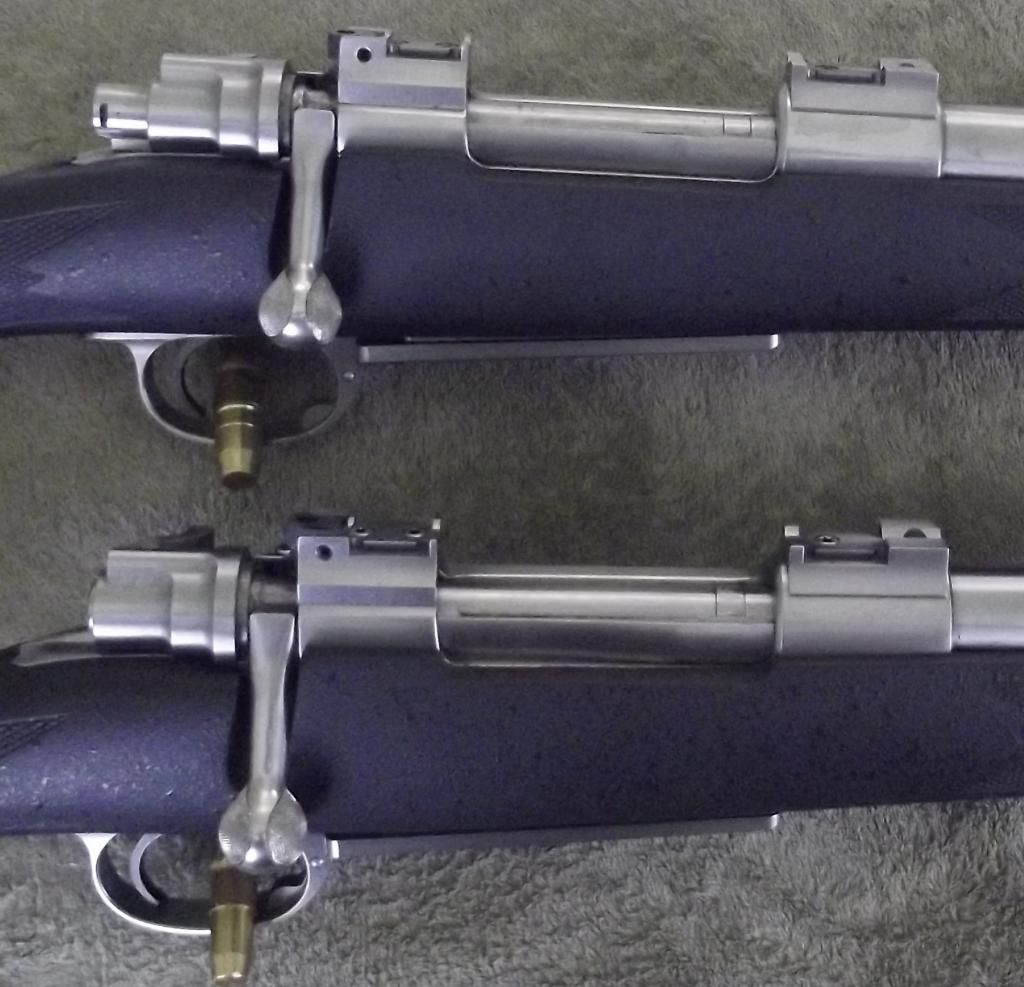 |
Definitely an interesting dilemma... Will be interesting to see if QC will divulge the source of their basic brass sans headstamp. So...presuming sufficient neck tension for bullet retention...does the lessor neck wall thickness affect accuracy? If no loss in accuracy...does this mean a need for multiple resizing dies to accommodate the difference in neck wall thickness? Jim "Life's hard; it's harder if you're stupid" John Wayne | |||
|
| one of us |
I can't see any difference in the thick or thin in my rifle. Plus these aren't 300yd varmint rifles. I have some Howell basic brass that is on it 7th(at least) loading. For the most part they weren't plinking loads. As usual just my $.02 Paul K | |||
|
| new member |
I have: QualCart brass... CH4D dies... an 85+ yr. old rifle... and this forum... a usable rifle. thanks again. | |||
|
| one of us |
Fresh thought or blasphemy: Make a new reamer for the 400 Whelen. Use the same shoulder angle, shoulder diameter, and distance to shoulder as the Kiff-Petrov reamer. Use the same headspace gage. Just take that huge taper out of the neck. Instead of .004" of taper from neck-1 to neck-2, just use 0.001" of taper in the chamber/reamer neck. The existing reamer could be re-ground for this, or a new one made from scratch if better result more likely. This will make the shoulder more positive. There will be a full .020" difference in diameters of shoulder and neck-1, or more, depending on the neck wall thickness of the chosen brass. The cartridge will have a drawing with parallel-sided neck that is .004" smaller in diameter than chamber neck-2. The chamber will have neck-1 (at shoulder junction) that is 0.001" larger than neck-2 (at case mouth end of chamber). This the more usual configuration than the current 400 Whelen "funky neck." Various brass and loaded cartridge measurements must be checked. Should I call this the "400 Whelen New Neck" or "400 Whelen Improved Neck" ("400 WIN") or just another "400 Whelen Improved" ... ??? New reloading dies from Hornady Custom would be cool for 400 Whelen, whether old or new neck. Alas, current rifles would need to have barrels set back a half inch, or re-barreled. I will go lie down now and see if this idea goes away or stays. | |||
|
One of Us |
What happened to “if it ain’t broke don’t attempt to fix it!” Edit Added: I should say I don't have one - but now that the historical-correct 400 Whelen reamer specification is being so well documented by mess with it. But if you do then add a hyphen behind the Whelen along with another identifier so that it'll be well distinguishable from the original... Jim "Life's hard; it's harder if you're stupid" John Wayne | |||
|
| One of Us |
FYI, Just to let everyone know the .400-Whelen reamer just went to the last guy on list and is headed to GA this morning. If anyone needs it I can have him mail it to you. With the reamer is a spare, and different size removable pilot and a "GO" headspace gauge made using my G&H .400 Whelen. Same rule applies to all, you only pay postage and if-you-break-it-you-buy-it. | |||
|
| one of us |
Thanks for playing Jim! I have had nagging doubts about the 400 Whelen neck dimensions, and it has come to a head! Could it be they had thicker-necked brass in the beginning? Did "Towny" (as Jack O'connor called his good friend and mentor Townsend Whelen) fear "the dreaded donut?" Why else have a neck-1 of chamber that is .004" bigger than neck-2 of chamber? A difference of .001" there is more routine. So the current 400 Whelen just throws away .003" of shoulder. The difference in diameters of the shoulder and neck-1 is 0.017". It could easily become 0.020" just by reducing the taper of the neck to only .001" instead of .004" We could even reduce the neck-2 by .001" also, then neck-1 can be reduced by .004" and the shouder will be .021" total, or 0.0105" per side instead of only 0.0085". This will leave the cartridge neck-2 still at same 0.433" maximum, with chamber neck-2 of .436" minimum. Still a tolerance of +.003". Cartridge neck-1 will also be .433" maximum for loaded ammo, with chamber neck-1 being .437", or +.004" there. This is still huge, if our best brass now is .009" neck wall thickness. That indicates .411" + (.009")x2 = .429" for loaded cartridge neck diameter. If brass neck wall thickness is increased to .011", the loaded cartridge neck diameter would be .433". A perfect fit. If brass neck wall thickness increased to .012", loaded ammo neck diameter would be 0.435": Too tight, just .001" and .002" of plus tolerance. I will wait until I confer with Rusty (roughone) about brass measurements, before I go ordering any new reamer for the "400 Whelen of 2013." That's "400 Whelen-13" for those who like hyphens. If I do order another reamer, it will also have an extra 0.100" of parallel-sided free-bore length. Increased from 0.188" to 0.288". That will give the 400 PDK some competition, from a 2.49"-long 400 Whelen of 2013. "Forty-Thirteen" or 40-13 for shorthand. Any new reloading dies from Hornady Custom will be optimized for the Standard 400 Whelen brought to us by Michael Petrov, using current thin-necked brass. They will be perfect for the 40-13 also, which uses the same headspace gage, same shoulder diameter, same shoulder angle. | |||
|
| one of us |
Preliminary 400 Whelen-2013 chamber: 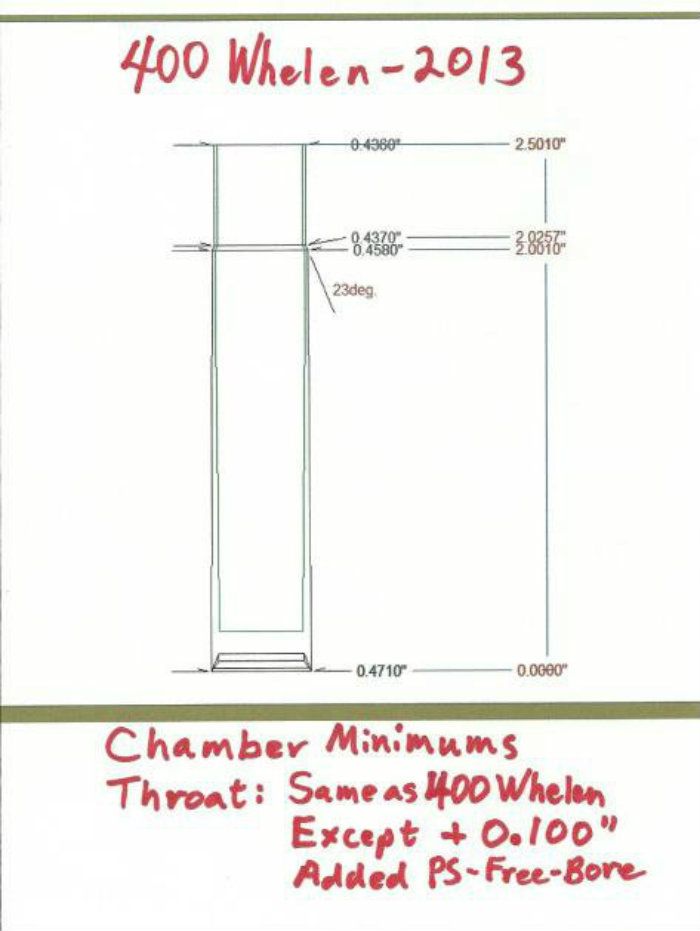 | |||
|
| One of Us |
This thread is entirely too complicated for me. | |||
|
| one of us |
Carbonic Acid: Are you not a Wildcat fan? There are more Wildcat fans than Cardinal fans in Kentucky, overall. Wildcatting is a habit that is hard to kick, but I don't mean Rupp Arena. I mean: (Just a little loose association and flight of ideas to prove it.) What would be best for a 400 Whelen-2013? A stainless M70 that is now a 35 Brown Whelen, or a stainless Ruger M77 MkII 30-06? (The Pre-64 M70 35 Whelen is made from a 1952 action and a 1958 stock. Strangely enough 35 Whelens were never made at the Winchester factory ... nor 400 Whelens.) 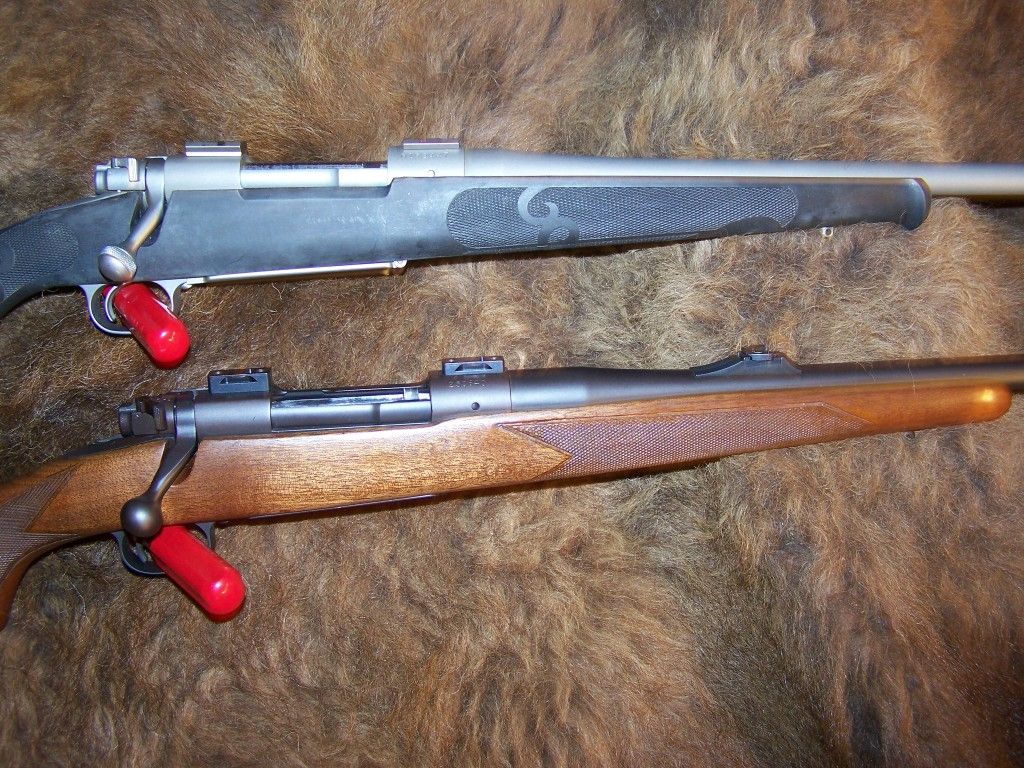 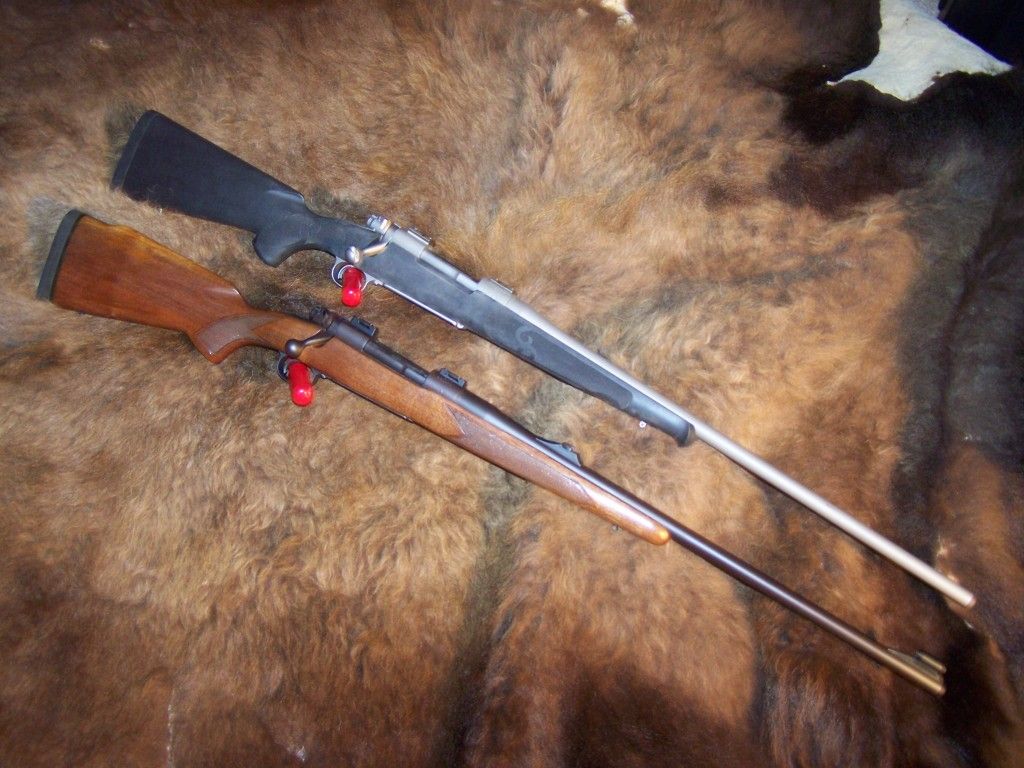 | |||
|
| One of Us |
Sure, I like the idea of wildcattin' and speermintin' but in my nayburrhood, shootin' rifles is frowned upon by the local constabulatoree. Although, shootin' a big boomer up by the sign might be a stunt dujour. I prefer the blued/wood look for a revivalist caliber. | |||
|
| One of Us |
I am still stongly considering doing a 400 Whelen project when I get some other stuff paid for. I am not much of a wildcatter and can only follow about half of what RIP is saying with regards to the modifications to the case/reamer. I do believe in the KISS (Keep it simple, Stupid!) philosophy when it comes to my reloading/wildcatting ability so I think I would go with exactly what Mr. Petrov has done above. Really enjoy reading all these thoughts that everyone is posting on the 400 Whelen though! 30+ years experience tells me that perfection hit at .264. Others are adequate but anything before or after is wishful thinking. | |||
|
One of Us |
Play… Ok here goes… Thicker-necked brass? “Dreaded donut?” Both are possible considerations; I extracted from Wikipedia with two quality references: Based upon this information, especially considering the Howe – of Griffen and Howe – is this same James Howe - yes it is very likely the Frankford Arsenal -06 basic cylindrical brass was thicker at the shoulder/neck junction when formed for the 400 Whelen than the commercially available -06 brass used of the day and the principal reason the chamber was designed with the specifications it has. So with that said why not go back to basics… We – the collective we – do not have access to Frankford Arsenal -06 basic cylindrical brass. So that leads us to the need to identify what we have ready access to…ready access in the sense that the brass should not form shorter than the ‘trim-to’ specification for the cartridge. So with this in mind, what brands of -06 based brass (regardless of the cartridge headstamp) will: 1) Will meet this minimum ‘trim-to’ length specification? 2) Will give a shoulder/neck junction dimension that is larger in diameter than the mouth diameter? 3) Will not have ‘too much neck slop’ in the loaded diameter of the case neck in comparison to the relating chamber dimensions? And if nothing is readily available to meet these criteria then it makes perfect sense to create an updated 400 Whelen-2013 specification to accommodate ‘what we have ready access to’… Reminds me… Has anyone contacted Captech to determine how their Jamison -06 based cylindrical brass will form out? And has anyone measured the two neck diameters the QC 400 Whelen brass with a true 0.411” diameter bullet fully seated? And I can’t help myself… While a difference of .001" there is more routine let’s take a look at a couple of modern – somewhat popular long-range cartridges – and see what the CIP specifications are for chamber and cartridge: 300 Lapua Magnum: Chamber H1 (shoulder/neck junction): 0.34764” / 8.83mm Chamber H2 (mouth/chamfer junction): 0.34528” / 8.77mm Difference: 0.00236” / 0.06mm Cartridge H1 (shoulder/neck junction): 0.34567” / 8.78mm Cartridge H2 (case mouth): 0.34370” 8.73mm Difference: 0.00197” / 0.05mm 338 Lapua Magnum: Chamber H1 (shoulder/neck junction): 0.37441” / 9.51mm Chamber H2 (mouth/chamfer junction): 0.37205” / 9.45mm Difference: 0.00236” / 0.06mm Cartridge H1 (shoulder/neck junction): 0.37244” / 9.46mm Cartridge H2 (case mouth): 0.37047” / 9.41mm Difference: 0.00197” / 0.05mm Guess this is what even the manufacturer has to do when using thicker walled cylindrical brass – than traditional – to form their brass… Geez…almost forgot about the last… That is a greater free-bore than the 12.7x68/49-10, 500 AR Nyati, or 500 Bateleur… Yes it is less than you’re using in the .375/404 JS…but why so much? I’d recommend either keeping the current specification or using a maximum 0.213” free-bore… The available .411 caliber bullets – even single loading those designed for the 408 CheyTac cartridge – certainly don’t require the longer free-bore… And finally... Rifle - These days I lean towards stainless with either a black synthetic stock or a nice walnut wood stock... M70 Winchester or M77 Ruger - whichever floats your boat, both will work just fine... Am I playing ok Ron? Jim "Life's hard; it's harder if you're stupid" John Wayne | |||
|
| one of us |
You played really nice, Jim. Your Mother should be proud of what a fine gentleman she raised. To do list: Quality Cartridge 400 Whelen headstamped cylindrical brass, next batch due out this month: http://www.qual-cart.com/ Maker of 30-06 Blank Basic used for this? Neck wall thickness at 2.5"? Captech International 30-06 Blank Basic, next batch due out in 2014: http://www.captechintl.com/products.html Neck wall thickness at 2.5"? I am hoping for a neck wall thickness of 0.011" maximum and .009" minimum or about 0.010"+/- .001". That will work well in the 400 Whelen-2013 chamber. Or maybe 0.0105" +/- 0.0005" just to be more precise, and slightly on the thicker side: 0.010" to 0.011" Too much to ask for? Custom dies for the "400 Whelen-2013" would be perfect for the "400 Whelen-1923" also. Circa 90th Anniversary. | |||
|
| One of Us |
I have some Frankford Arsenal FA-18 (1918) cylindrical brass and the wall thickness is .011". FYI: http://www.24hourcampfire.com/.../7287330#Post7287330 | |||
|
| one of us |
Michael Petrov, That sounds like a good thickness. Is that brass of yours short like 2.455" on the other thread you linked? Even with that thickness, one could do a cartridge neck like this and have more shoulder step, and dies for this would work in the 400 Whelen-1923: 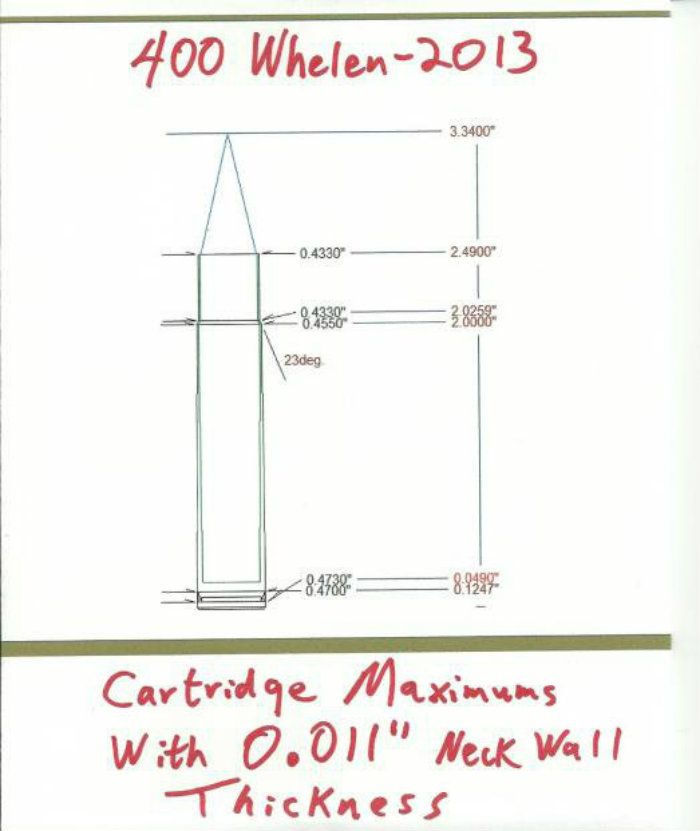 Maybe the current dies for the 400 Whelen-1923 do not size the shoulder much below the chamber minimum of .458" (your reamer). That could be another fortifier of the 400 Whelen shoulder. Your loaded brass is .456" at the shoulder eh? There is a lot of misspeak going around saying the 400 Whelen cartridge shoulder is supposed to be .458" (maximum), when that is actually the chamber minimum according to your reamer. Your reamer agrees well with the .455" cartridge shoulder you say that Towny specified. And Townsend Whelen actually rebarreled his 400 Whelen Springfield '03 to 35 Whelen? | |||
|
| one of us |
Michael Petrov, Mart, What do you find the Quality Cartridge brass to measure in neck wall thickness as cylinder and after necking down? What is the OD of the middle of ammo neck with .411-cal bullet properly loaded in the QualCart brass? How long is the cylinder brass as it comes from Quality Cartridge? I'll search back and see if anyone has posted this before, I don't recall. Thanks. | |||
|
One of Us |
I need to pick up a canneluring tool as well to use with my 500gr Hornady's... And yes, it's time to start measuring so you can finalize the actual freebore needed... Jim "Life's hard; it's harder if you're stupid" John Wayne | |||
|
| One of Us |
| |||
|
| One of Us |
The "FA-18" brass is 2.490" OAL. | |||
|
| one of us |
RIP, I don't have any Qual Cart that is not already sized and I don't have a good mike for neck thickness. My loads with Qual Cart brass and a 400 grain Woodleigh measure .4365 about midway down the neck. I trimmed my brass to 2.495. I don't recall what the original length was on the Qual Cart cylindrical but I do remember it was a bit long. I ended up trimming perhaps a sixteenth to a tenth of an inch to get to the 2.495. Wish I could be of more help. Mart "...I advise the gun. While this gives a moderate exercise to the body, it gives boldness, enterprize, and independance to the mind. Games played with the ball and others of that nature, are too violent for the body and stamp no character on the mind. Let your gun therefore be the constant companion of your walks." Thomas Jefferson | |||
|
| one of us |
Michael Petrov's Quality Cartridge brass being 0.0110-0.0115" in neck wall thickness and 2.520" long bodes well. Mart's 0.4365" loaded, mid-neck diameter seems to be perfect for the neck taper of the current Kiff/Petrov reamer for 400 Whelen-1923. Both you guys use RCBS dies with good results. I wonder if the dies have anything to do with tapering the brass neck to make it tight at the end (neck-2) and loose at the shoulder (neck-1). That could make for a tendency toward poor neck tension, especially with thinner brass in neck wall. I am not finished with obsessing and compulsing over this, but will go ahead and get some RCBS dies and continue using some imperfect CH4D dies for now, and imperfect brass, waiting for the QualCart stuff. After my "show me" measurements for myself, the 400 Whelen-2013 reamer and dies is still a possibility. Thought I would have time today to make some phone calls about brass, but was just too busy. Will try an email to Captech tonight. Still wondering about the source of QC brass, but now happy about about its measurements. Thanks, y'all. | |||
|
| one of us |
Boy you guys sure make it complicated. Sure glad I went wildcat. As usual just my $.02 Paul K | |||
|
| one of us |
RIP, I actually have the CH4D dies. I have been pleased with them. I was able to buy a lot of components for the price difference between mine and the RCBS dies. Mart "...I advise the gun. While this gives a moderate exercise to the body, it gives boldness, enterprize, and independance to the mind. Games played with the ball and others of that nature, are too violent for the body and stamp no character on the mind. Let your gun therefore be the constant companion of your walks." Thomas Jefferson | |||
|
One of Us |
Jim "Life's hard; it's harder if you're stupid" John Wayne | |||
|
| one of us |
| |||
|
| one of us |
Mart, My bad. So you get by just fine with the CH4D dies and brass that is thick enough in the neck, eh? Close enough. I called Huntingtons, they said call RCBS, and RCBS said talk to the Custom Die department there, and I got an answering machine. I left a number. The 3-hour time zone difference made the calls possible to California today, at the end of my day. Thought I would just check and see. Still waiting for responses on brass, emails, night get a chance to telephone also ... I think I will get Hornady to make the custom dies, and then I will know for sure what I am getting ... sort of like ramrod340. | |||
|
| one of us |
RIP, Yes so far I've had no trouble with the CH4D dies. I have loaded Qual Cart brass, some Norma cylindrical, some LC 62 match and a few varieties of commercial brass. So far the only problem I've had with neck thickness and bullet diameter has been with the Speer .416s that I sized to .411. I used a .411 Lee sizer that I got from Ranch Dog when he was still in business. I need to try a regular .410 from Lee because the bullets are springing back to .412-.4125. They come out out dead on .411 but within a day they spring back a little. Makes it just a touch tight closing the bolt. They shoot great but I wouldn't want to need a second shot fast. Mart "...I advise the gun. While this gives a moderate exercise to the body, it gives boldness, enterprize, and independance to the mind. Games played with the ball and others of that nature, are too violent for the body and stamp no character on the mind. Let your gun therefore be the constant companion of your walks." Thomas Jefferson | |||
|
| one of us |
It's remarkable to me that a 400 Whelen thread has been this popular. I believe the 400 Whelen just might be the cartridge of 2013. I see it becoming so overwhelmingly popular that it will be offered by every gun company. They will be offering it in every manner of gun. It will become so popular that Springfield Armory will gear up and turn out a few new 1903's to be turned into historically accurate copies of the original versions. It will be offered in pumps, autos, bolts, lever guns, and single shots. Of course I could be wrong. It's been known to happen before. Often. "...I advise the gun. While this gives a moderate exercise to the body, it gives boldness, enterprize, and independance to the mind. Games played with the ball and others of that nature, are too violent for the body and stamp no character on the mind. Let your gun therefore be the constant companion of your walks." Thomas Jefferson | |||
|
| one of us |
Fresh thought: 400 Whelen-1923 versus 400 Whelen-2013 ... Nostalgia versus better ... Back in the old days there was a fixation on taper to make for better extraction. Could this be the reason for 4-thou of taper in the 400 Whelen-1923 chamber neck, which just throws away 3-thou of shoulder-neck1 difference? About 8.5 to 9-thou of taper per inch of case body length is a good thing. Why the heck is it needed in the neck? Do not the reloading dies create-parallel-sided neck brass for bullet seating? Ken Howell was not very clear on the brass specs here, as he gave a neck-2 of 0.430" and did not specify a neck-1 at all: 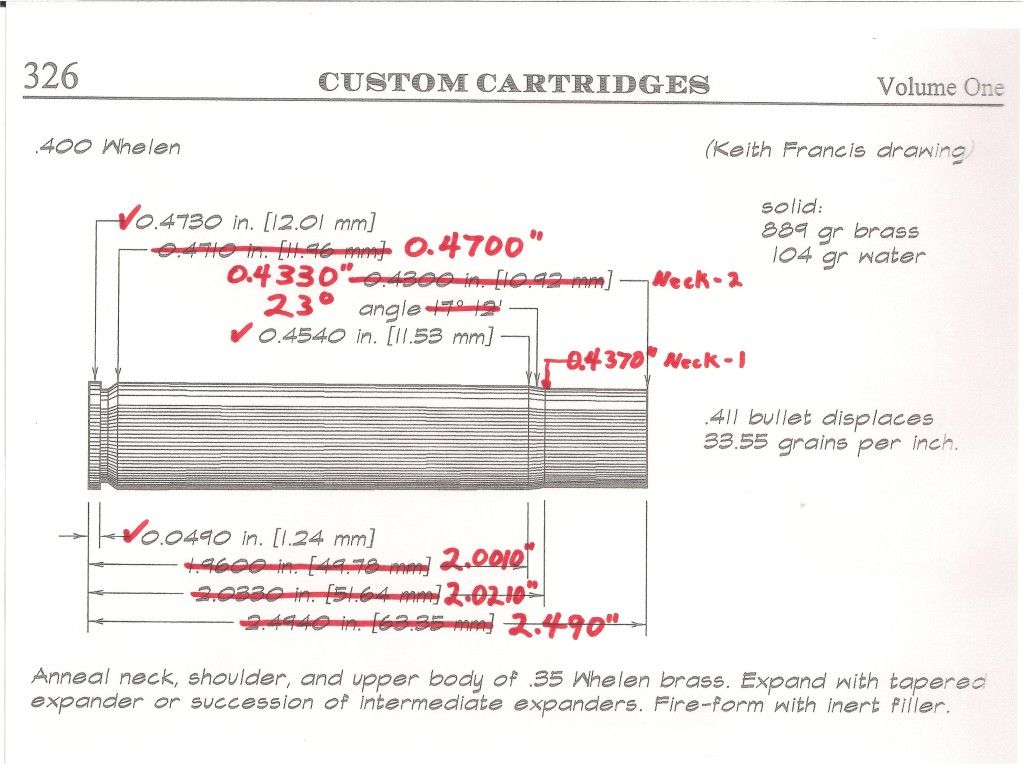 The above would indicate a neck wall thickness of 0.0095". An extra 0.100" of free-bore would make a new reamer worthwhile in itself, besides increasing the shoulder step of chamber and brass!!! Nostalgia is the only reason not to go for a 400 Whelen-2013. | |||
|
One of Us |
Everything I've read indicates concern over the 'quality' of brass as well as bullet composition and how each performed - or held together - under pressure and velocity. This is even a concern with today's brass and bullets. Example - the Huelsen-Horneber 500 MDM brass that Michael special ordered suffer 'sticky extraction' when he loads to 62K psi but'll extract fine if he keeps the pressure <= 60K psi. Why? My perception is because the Huelsen-Horneber did not properly prepare the cases to meet their parent RUM case's 65K psi PMap. Who knows if these cases would extract if actually fired at 65K psi. I reckon if Michael's 500 MDM was spec'd with a similar neck taper the extraction wouldn't be quite as sticky but none the less soft brass is a problem! Jim "Life's hard; it's harder if you're stupid" John Wayne | |||
|
| One of Us |
This reminds me of a guy talking about being in a meeting where they were arguing about the chamfer on the edge of a pyrolytic carbon heart valve leaflet. The argument was a .0005 chamfer vs a .001 chamfer. | |||
|
| one of us |
We are about an order of magnitude less here than that! | |||
|
| one of us |
I have 3 pieces of Qual Cart 400 Whelen brass, thanks to Gordon. It looks pretty thick in neck wall, will get it measured. This may be perfect with the existing reamer. | |||
|
| one of us |
Just a thought. If you are having custom dies made and think you might use more than one type of brass use the brass with the thinnest neck when you have the dies made. A thicker neck will be opened from the inside with the expander. If you have die made using a thick neck and switch to thin you might end up without enough neck tension as discussed above. Hornady custom dis for the 400 should be a three piece set. As usual just my $.02 Paul K | |||
|
| one of us |
ramrod340: You are correct as usual. Yes, I have a feeling I am going to get Hornady to make some dies for the 400 Whelen, based on a thin neck wall dimension, even if I do not get a new reamer for the 400 Whelen-2013. Houston: We have a problem. The Quality Cartridge brass lot that Gordon (gordief) got his brass from has a QC problem. There is a band of about 1/4" length at the mouth that is too thick, compared to the wall thickness below that. You can see it even with my cheap camera: 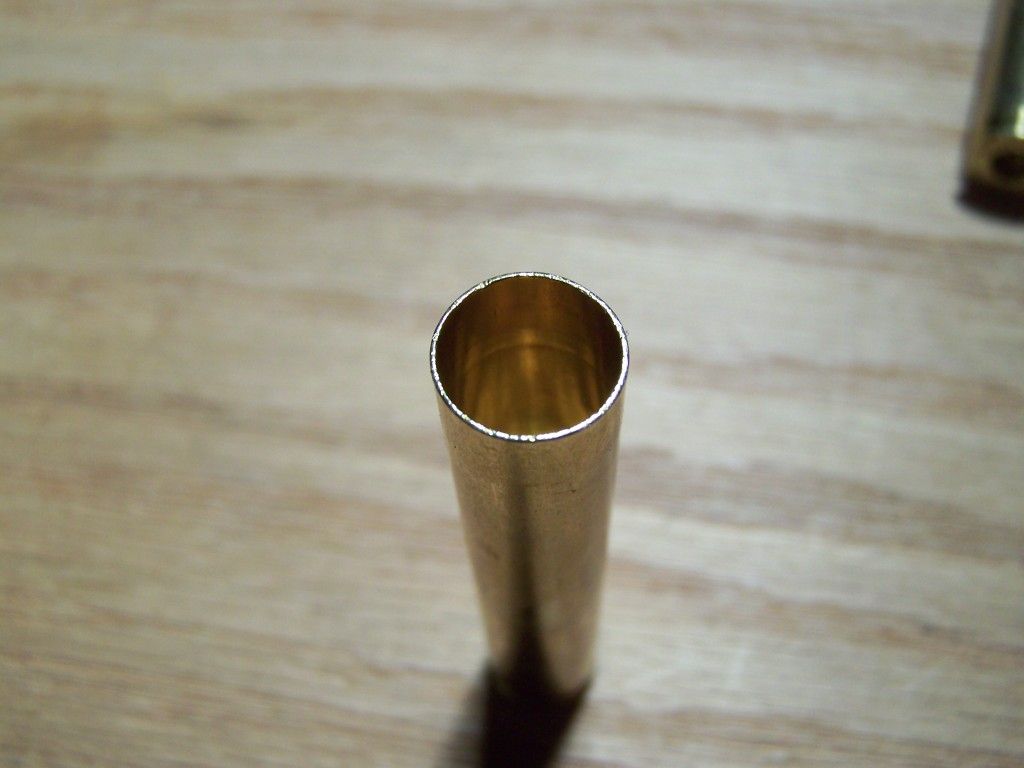 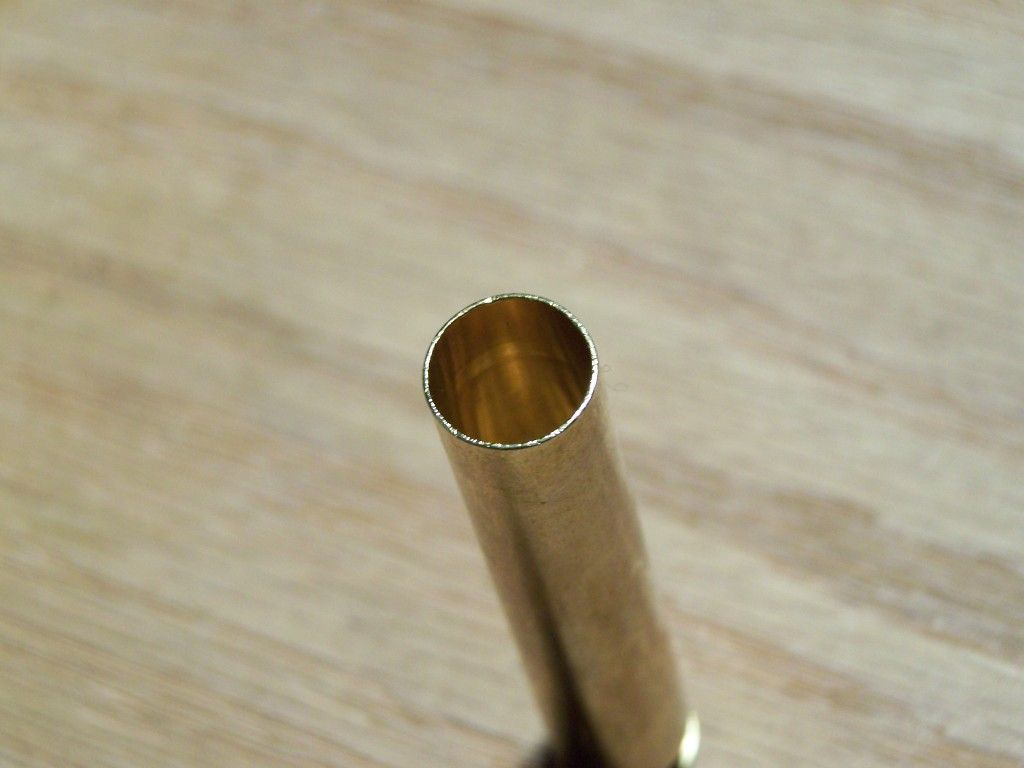 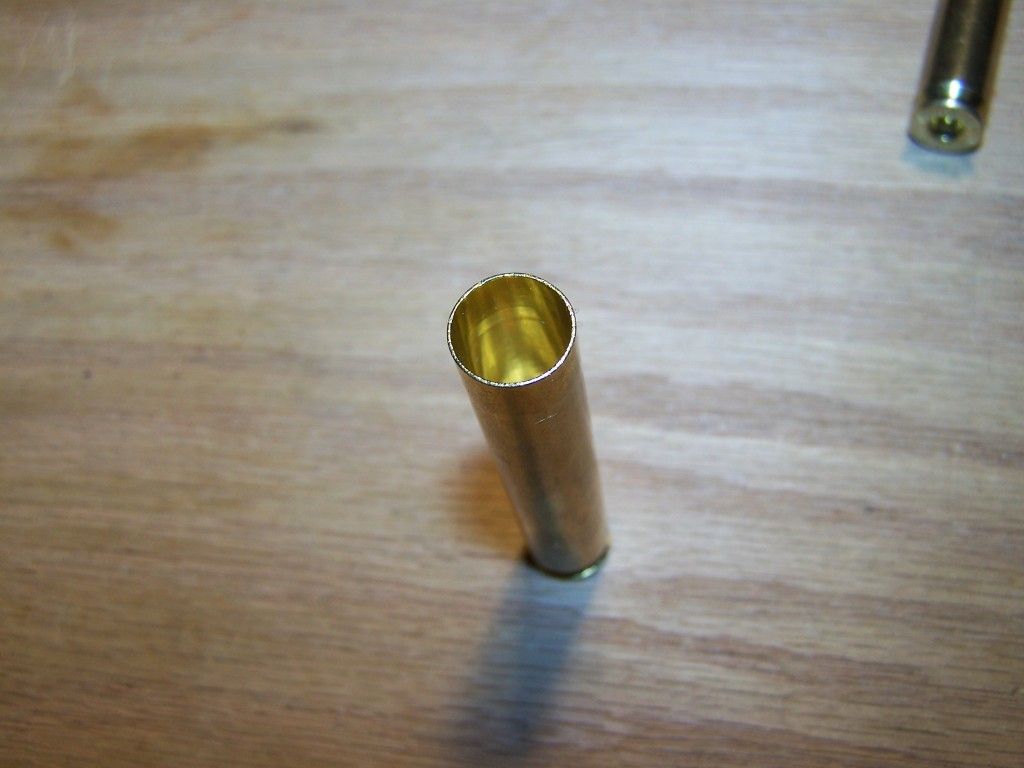 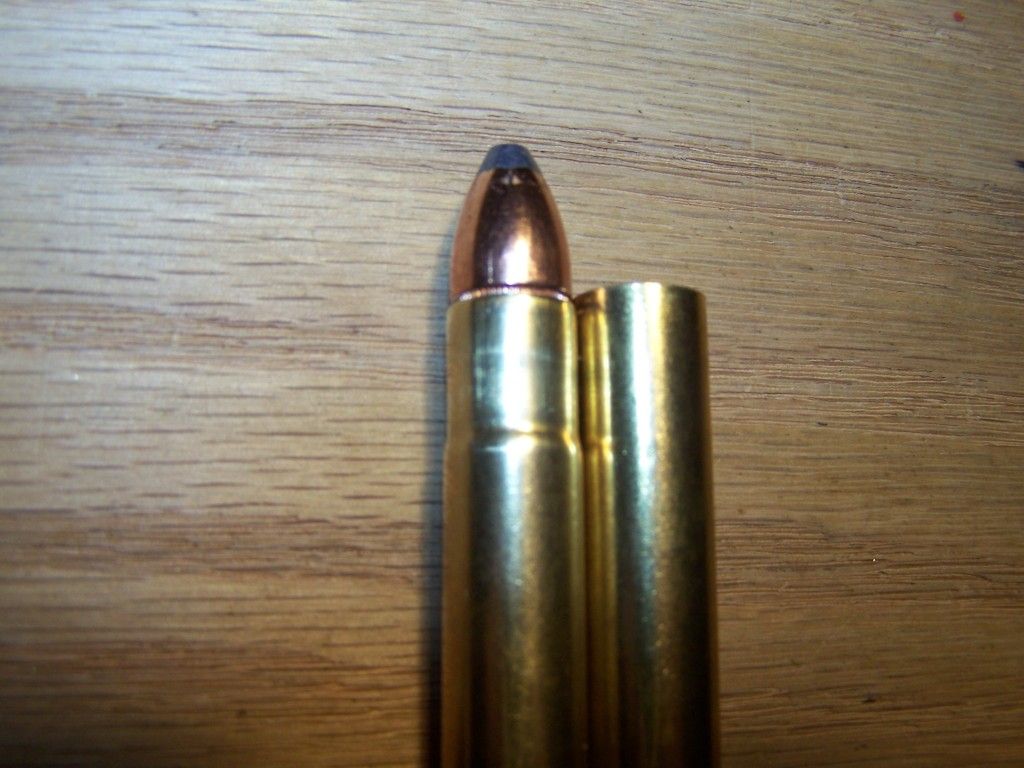 When you size the basic brass down to 400 Whelen, the neck wall thickness at the end of the case increases from about 0.0120" to 0.0130". But that is only for the distal 1/4" of the case. Below that (baseward) the neck wall is thinner by about 0.0020" to 0.0025". Some loaded brass dimensions with the .411" diameter Hornady 300-grain SP:  (TYPO ON ABOVE: Brass length before sizing and trimming is 2.558" not 2.588".) This is obviously a quality control problem with that lot of brass. Peter Cardona should be advised of this. If the next batch of Quality Cartridge 400 Whelen brass is like this, then outside neck turning (after sizing down to 400 Whelen) will be required to reduce the neck wall thickness to a uniform 0.010" to 0.011" thickness. I will get custom dies made when I have a usable batch of brass to my liking. I will also get a custom reamer made with some extra free-bore to my liking, for the 400 Whelen-2013. It will have to be suitable for the brass. I am on hold until I get about 200 pieces of brass I want to stick with. But I will continue to try to develop loads with the inferior AHR brass until then. Quality Cartridge brass base diameter and rim diameter are ideal: 0.469" rim, 0.467" base (above extractor groove), with a nice radius on the entry to the primer pocket AHR: Rim diameter is too small: 0.466" And the AHR head too large: 0.469" to 0.470" And the AHR primer pocket has a sharp edge on the hole, needs to be beveled or radiused. And the AHR neck wall thickness is thinnest of all. All of this adds up to "PROBLEMATIC" AHR brass. I have had one stuck case and Rusty has had two stuck cases already with the AHR brass, even when well lubed. Ripped that thin rim right off. No such problems with Quality Cartridge brass expected, nor experienced, so far. Ideal is to have a head and rim diameter that are about 0.003" to 0.004" less than the brass max spec of 0.470" and 0.473" respectively. Quality Cartridge brass does that. Need to make sure the neck wall thickness is uniformed on the Quality Cartridge brass. (Rusty McGee, Gunsmith's calipers (+/- 0.0001" capable) were used for measurements reported in this post. He has the tools and instruments. I have the products of his labor.) | |||
|
| Powered by Social Strata | Page 1 ... 4 5 6 7 8 9 10 ... 33 |
| Please Wait. Your request is being processed... |
|
 The Accurate Reloading Forums
The Accurate Reloading Forums  THE ACCURATE RELOADING.COM FORUMS
THE ACCURATE RELOADING.COM FORUMS  Rifles
Rifles  Big Bores
Big Bores  Any fresh thoughts on the .400 Whelen
Any fresh thoughts on the .400 Whelen

Visit our on-line store for AR Memorabilia

